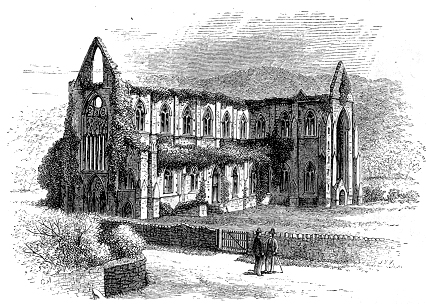|
|
On The Welsh Border.,
Page 9 of 14  Tintern Abbey, From The Road.
The community at Tintern was only 150 years old when they built the magnificent abbey whose ruins now stand in lonely splendor here on the Welsh bank of the Wye. In this abbey they lived in princely style, dispensing the most sumptuous hospitalities, and more than once entertaining kings at their table. Their glories began to decline in the fifteenth century, and when the Reformation came, and Henry VIII. dissolved the monasteries throughout Great Britain, there were but thirteen of the brotherhood remaining in Tintern. The ruins are now the property of the much-enduring Duke of Beaufort, and being his, are kept in the tidiest possible trim by a custodian who lives most comfortably in one of the corners of the old pile.
The first sight of Tintern Abbey from the hill on the Chepstow road almost warrants the claim which has been made for this ruin that it is the most picturesque in Britain. Yet the claim is made less on account of the exterior than of the interior. It stands in a secluded and romantic valley, close to the banks of the Wye, surrounded by cultivated hills and embowering trees. On drawing nearer you find that its immediate inclosure is a level, grassy lawn surrounded by stone walls, and with a wooden gate opening off the smooth highway which runs in front of its western facade. Here at a glance we are able to comprehend the ruin in its entirety; nothing is hidden, nothing covered up or left unexplored. The bright free sunshine bathes the ruin in one broad lake of pure golden light. No trees intercept the vision. There were trees in the grounds near the road a short time ago, but they so shut off the view that they have been cut down. The façade nearest us is the main entrance to the church, which is the part of the abbey now most complete, or rather least destroyed. On the other side are the ruins of the cloisters, parlors, dining-hall, kitchen, chapter-house, etc., much fallen to decay. The limb of the cross which juts out with its tall peak on our right is the south transept. The great window which occupies so large a part of the principal façade is an exquisite specimen of rich Gothic ornamentation. It is not, however, until we have passed into the church that the really sublime effect of this grand ruin bursts upon us. The gaze sweeps down the entire length of the vast nave to the marvelously light and elegant window which lifts its graceful stone mullion at the opposite end of the church. Along the sides of the perspective stands a range of fine Gothic pillars, some rising completely to the arches, others quite crumbled to their base. Overhead he only roof is the high blue sky. Along he summit of the ruined walls we see a wealth of ivy, and paths where people, visitors like ourselves, are walking securely about. Passing to the right, we stand in the south aisle, the entrance to which from without is now walled up. The view here is hardly less impressive and majestic than the other — a vista of crowding arches, walls, and windows, among which the ivy riots luxuriantly. Here within a railed space is a collection of encaustic tiles, relics of former elegance, bearing various designs, as flowers, animals, and the arms of the abbey donors. Halfway down this aisle we come to the south transept, where stands the mutilated statue |
|
9
Books & articles appearing here are modified adaptations
from a private collection of vintage books & magazines. Reproduction of these pages is prohibited without written permission. © Laurel O'Donnell, 1996-2006.
|
|

